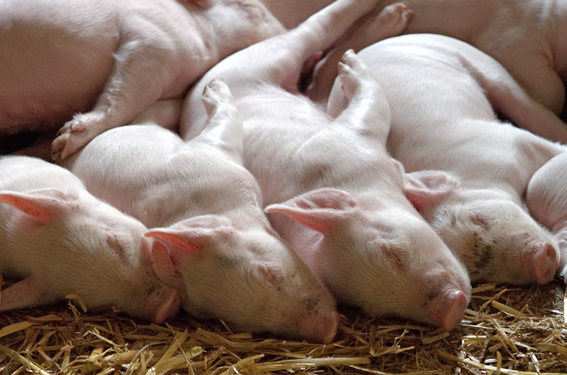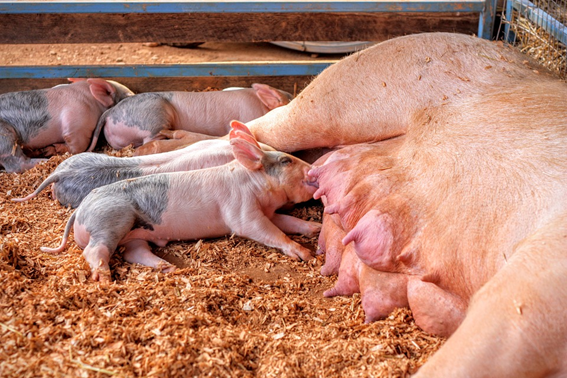12 May 2022
What is Cross-Fostering?
Cross-fostering is a management technique in pig farming where piglets are removed from their biological sow and placed in another litter. The main objectives of cross-fostering are to create more regular litters to allow each piglet to access a functional teat and to improve small piglet survival.
Cross-fostering is widely used and up to 98% of commercial pig farms cross foster piglets (Calderón Díaz et al., 2018). Some authors believe that cross-fostering should be kept to a minimum and it is estimated that only 5% of piglets need to be cross-fostered (Calderón Díaz et al., 2018; Pajžlar & Skok, 2019). However, many commercial farms cross-foster up to 100% of their piglets to maximise the benefits of litter standardisation (Muns et al., 2014).
Several techniques fall under the umbrella of cross-fostering. At its most basic, cross-fostering happens when litter size exceeds the number of available, functional teats, and surplus piglets are moved to a sow with fewer farrowed piglets. This usually takes place within the first 24 hours of life. Some farmers who practise this type of early cross-fostering also choose to standardise litters by weight: small piglets are placed with small peers, medium piglets with medium, and heavy piglets with heavier ones. Therefore, there are two types of cross-fostered litters: uniform and mixed.
Although not recommended, piglets are often cross-fostered during the first, second, or even third week of lactation. Rather than equalise litter size, this type of cross-fostering is aimed at salvaging small or fading piglets and keeping body weights within a litter as uniform as possible.
Shunt fostering is a similar technique and consists of gathering small piglets from several litters and fostering them with a new nursing sow—usually one whose litter is about to be weaned. Another technique that farmers should keep in mind is swapping whole litters. For example, if a litter is composed mainly of small piglets that are starting to fade, it can be swapped with a heavy litter: the smaller litter will have access to better nursing, whereas the more active one will force the sow to start lactating.
Benefits of Cross-Fostering
Cross-fostering is a practice that became widespread out of necessity, as the number of farrowed piglets usually exceeds the functional teats available. It makes sense to cross foster some piglets to sows with a smaller litter and more available teats. Here are some benefits of cross-fostering:
Decreasing pre-weaning mortality
A principal objective of cross-fostering is to reduce pre-weaning mortality. According to several authors, cross-fostering increases the survival rate between 10% and 40% in cross-fostered litters (Heim et al., 2012).
Giving all piglets access to a functional teat
By standardising litter size, piglets are more likely to have access to a functional teat. Modern sows can farrow, on average, 14 to 17 piglets with fewer functional teats available (Vande Pol et al., 2021). These surplus piglets can be cross fostered with sows that farrowed smaller litters.
Giving small piglets access to a smaller teat
One of the reasons that small piglets fade is that, even if they have access to a functional teat, it might be too big for them to nurse. This is often the case with high parity sows. Therefore, cross-fostering smaller piglets with lower parity sows—which often have smaller teats—allows them to nurse and grow normally.
Standardising litter size
Cross-fostering allows farmers to equalise litter size to 12 to 15 piglets of similar birth weight. In theory, smaller piglets will not have to compete with heavier littermates for teat access, which improves the pre-weaning survival rate of light-weight uniform litters (Vande Pol et al., 2021).

Standardised litters reduce competition between littermates and allow smaller piglets access to a functional teat.
Disadvantages of Cross-Fostering
Even though it is widely practised by pig farmers, there are some important cross-fostering disadvantages.
Cross-fostering entails extra management and costs
Pig farmers need to keep in mind that adopting any new technique in the farm entails some costs. Personnel might need some extra training and cross-fostering might not be effective at all if there are some other, deeper problems on the farm. For example, if infectious diseases are causing high mortality among piglets, then cross-fostering is unlikely to be helpful until more pressing health problems are solved. The greatest concern when cross-fostering is that farmers might be allocating precious resources to piglets that are not viable in the first place.
Cross-fostering might not be beneficial for heavier piglets
When standardising litters, not only by size but also by birth weight, small pigs benefit markedly and gain greater pre-weaning survival. However, there is a detrimental effect on heavy piglets that persists from the farrowing pen to the slaughterhouse (Huting et al., 2017; Vande Pol et al., 2021). In uniform cross-fostered litters, heavy piglets have to compete with equal-size littermates, so they lose any advantage they might have enjoyed in their biological litters. It should also be noted that heavier litters place greater demands on the lactating sows. While it might be beneficial for small piglets, cross-fostering might be harmful when considering the big picture!
Cross-fostering might be detrimental to animal welfare
When pigs are cross fostered within the first 24 hours post-farrowing, before the teat order has been established, then piglets usually adapt quite well to their new litter (Calderón Díaz et al., 2018, Muns et al., 2014). Nevertheless, if the teat order has already been established, then it is likely that piglets will miss several nursing, they will fight with their peers, refuse to nurse, and will not adapt to their new litter. Calderón et al. (2018) observed different cross-fostering practices in a large commercial farm in Ireland. They discovered that 59.2% of cross-fostered piglets were moved litters on week 2 of life or later.
The same researchers also found an increase in ear lesions in piglets cross-fostered during week 1, but more tail lesions on those fostered in week 2. This raises many animal welfare concerns. Nevertheless, Muns et al. (2014) observed that, when done in the first 24 hours, cross-fostering does not disrupt nursing.
How to Choose Nursing Sows
When cross-fostering piglets, farmers need to decide which sow to use for the pigs. As a general rule, it is never a good idea to take piglets from one farrowing group to another, as this can spread diseases throughout the farm. Within a group, there will be lactating sows, gilts, multiparous high parity sows, and multiparous low parity sows.
The nursing sow should be chosen according to the piglets’ needs. For example, smaller piglets should be placed with multiparous lower parity sows, whereas heavier piglets will fare fine with a high parity sow. Primiparous sows (gilts) can be used to cross foster piglets, but there is a higher likelihood that they will reject the fosters. Gilts should not be given litters larger than 11 piglets.

Parity influences teat size as well as nursing ability.
Cross-fostered piglets fare much better when placed on a younger litter, they adapt to nursing quicker, and they are less likely to miss nursing. Piglets also do better when their new litter is of a similar size to their biological one (Pajžlar & Skok, 2019). However, a younger, equal-size litter might not be available. As a rule of thumb, farrowing for cross-fostered litters should not be more than 4 days apart. The exception is when the nursing sow is chosen from the lactating population which piglets can already be weaned. In this case, a new litter is formed from fading and small piglets and given to the lactating sow. This is also called shunt fostering.
Piglets should always receive colostrum from their dams. It is also a good practice to boost cross-fostered piglets with some extra colostrum if available. Farmers can also resort to cow colostrum or commercial piglet boosters which contain colostrum, vitamins, and energy. Once a pig is cross fostered, it should not be moved to a new litter again. However, it should be noted that some advocate for continuous cross-fostering during the lactation period, to keep litters as uniform as possible. The latest research does not support this practice (Calderón Díaz et al., 2018; Vande Pol et al., 2021; Pajžlar & Skok, 2019).
Because the number of surplus pigs and the proportion between small and heavy pigs will change from farm to farm and from farrowing to farrowing, cross-fostering practices will need to change accordingly. There is no easy rule of thumb and pig farmers often have to make fostering decisions on the fly. However, each farm should establish a few guiding principles:
- Do not foster sick piglets with healthy sows.
- Do not foster piglets with sick sows.
- Always mark fostered piglets to avoid moving them again.
- Boost cross-fostered piglets and, if necessary, provide an extra lamp.
- Cross foster piglets as soon as possible.
- Ensure that cross-fostered piglets have had enough colostrum from their biological sow.
Pig Weaning Weight & Growth Performance
At weaning, piglets undergo one of the most critical and stressful moments of their lives, and there is not a lot of room for error. For example, weaning weight has more influence on overall performance than different feeds (Faccin et al., 2020). The gaps between heavier and lighter pigs at weaning only grow larger as time passes. Heavier pigs at weaning outperform their peers in every single production parameter: average daily gain, days to market weight, and carcass weight, to name just a few. For example, Faccin et al. (2020) found that heavy pigs weighed 2.1 kg above their lighter peers and that by day 42 this difference had grown to 5 kg. In the Calderón Díaz et al. (2018) study, lighter pigs that were cross fostered late had carcasses 4.9 kg lighter and had less muscle depth.
Cross-fostering is aimed, in principle, at reducing pre-weaning mortality. However, farmers should keep in mind that the goal is also to reach weaning with healthier, heavier pigs. Calderón Díaz et al. (2018) found that cross-fostered piglets have a higher mortality risk throughout the complete production cycle. This is because cross-fostered piglets are usually the lighter ones from their litter, so their low birth weight already puts them at risk.
In conclusion, cross-fostering should be aimed at reducing pre-weaning mortality, but also at increasing weaning weights. These goals can benefit from standardising litters early on, but not by continuously cross-fostering pigs throughout lactation.
References
Backus, G., Higuera, M., Juul, N., Nalon, E., & De Briyne, N. (2018). Second progress report 2015–2017 on the European declaration on alternatives to surgical castration of pigs. Boars on the Way. https://www.boarsontheway.com/wp-content/uploads/2018/08/Second-progress-report-2015-2017-final-1.pdf
Council Directive 2008/120/EC of 18 December 2008 laying down minimum standards for the protection of pigs. (2008). Official Journal of the European Union, 47(52), 5-13. https://eur-lex.europa.eu/legal-content/EN/TXT/?uri=OJ%3AL%3A2009%3A047%3ATOC
De Briyne, N., Berg, C., Blaha, T., & Temple, D. (2016). Pig castration: will the EU manage to ban pig castration by 2018? Porcine Health Management, 2(1), 1-11. https://doi.org/10.1186/s40813-016-0046-x
De Briyne, N., Berg, C., Blaha, T., Palzer, A., & Temple, D. (2018). Phasing out pig tail docking in the EU-present state, challenges and possibilities. Porcine health management, 4(1), 1-9. https://doi.org/10.1186/s40813-018-0103-8
Gallois, M., Le Cozler, Y., & Prunier, A. (2005). Influence of tooth resection in piglets on welfare and performance. Preventive Veterinary Medicine, 69(1-2), 13-23. https://doi.org/10.1016/j.prevetmed.2004.12.008
Holyoake, P. K., Broek, D. J., & Callinan, A. P. L. (2004). The effects of reducing the length of canine teeth in sucking pigs by clipping or grinding. Australian Veterinary Journal, 82(9), 574-576. https://doi.org/10.1111/j.1751-0813.2004.tb11207.x
Sutherland, M. A., Bryer, P. J., Krebs, N., & McGlone, J. J. (2008). Tail docking in pigs: acute physiological and behavioural responses. Animal, 2(2), 292-297. https://doi.org/10.1017/S1751731107001450
Sutherland, M. A., & Tucker, C. B. (2011). The long and short of it: A review of tail docking in farm animals. Applied Animal Behaviour Science, 135(3), 179-191. https://doi.org/10.1016/j.applanim.2011.10.015
Valros, A., & Heinonen, M. (2015). Save the pig tail. Porcine Health Management, 1(1), 1-7. https://doi.org/10.1186/2055-5660-1-2
